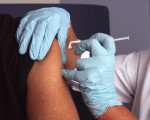by Michael Belkin – ICPA.org:
My business involves advising portfolio managers about asset allocation in global financial markets. During my career, I have observed several extreme speculative bubbles, including the Japanese stock market in the late 1980s, the NASDAQ frenzy in 1998–2000 and the U.S. housing bubble from 2006–2008.
These bubbles all ended in tears. I see the same elements now in the pharmaceutical industry’s preoccupation with vaccines. I coined the term “vaccine bubble” (in the book Vaccine Epidemic) to describe the economic and psychological factors that are driving the obsession with and over-investment in vaccines. The psychology of making big profits is causing a lemming-like rush into vaccine research and production. Ultimately, many of these companies and vaccine products will likely turn out to be flash-in-the-pan nobodies and nothings that simply waste investment and get discarded on the ash heap of medical history. In the meantime, families and individuals need to educate themselves and make informed decisions about vaccine acceptance or refusal.
The business model of vaccine manufacturers relies on compulsion—you must take their product, or else.
Investing in Health
Taking pharmaceutical company advice about vaccine safety and efficacy is like trusting a stockbroker or real estate agent to tell you the market is in a bubble. As investors and homeowners have learned the hard way, those with corrupt financial or professional incentives cannot be relied upon to provide trustworthy advice.
From a financial and industry perspective, here is what you need to know. Vaccines are licensed by the FDA and recommended by the CDC’s Advisory Committee on Immunization Practices (ACIP). Vaccine manufacturers perform (or outsource) their own efficacy and safety studies, so there is plenty of wiggle room for juggling the data. Manufacturers can choose their own placebo to either flatter efficacy or safety. If you think vaccine safety studies use saline solution for a placebo, think again.
The Merck Manuals (the pharmaceutical company’s best-selling series of medical textbooks) defines an adverse reaction to a vaccine: “Encephalitis is inflammation of the brain that occurs when a virus directly infects the brain or when a virus or something else triggers inflammation…. Encephalitis can occur in the following ways: A virus directly infects the brain. A virus that caused an infection in the past becomes reactivated and directly damages the brain. A virus or vaccine triggers a reaction that makes the immune system attack brain tissue (an autoimmune reaction).”
Thus, an adverse vaccine reaction that causes brain damage (encephalitis) has the same result as a complication from an infectious disease like measles. In vaccine safety studies, manufacturers can disguise the neurological damage caused by the vaccine they are testing by using another vaccine (or another substance that contains an aluminum adjuvant) known to cause neurological adverse reactions as placebo. The standard language they use is: “Adverse reactions were no different than placebo.” They don’t mention that the placebo causes neurological adverse reactions.
Another trick they use is to compare adverse reactions to a fully vaccinated population that has neurological damage from those vaccines. They claim it is unethical to compare vaccine adverse reactions in their new product being tested to unvaccinated controls, because the unvaccinated would supposedly miss out on all the great benefits of vaccines. This is a cheap statistical trick to camouflage adverse neurological reactions from vaccines.
Products in the Pipeline
The Pharmaceutical Research and Manufacturers of America’s (PhRMA) 2010 Report on Medicines in Development for Infectious Diseases boasts, “Among the medicines now being tested are…145 vaccines to prevent or treat diseases such as staph infections and pneumococcal infections.” The report didn’t include “medicines in development for HIV infection,” and stated, “A 2009 survey by PhRMA found 97 medicines and vaccines are in testing for HIV/AIDS and AIDS-related conditions.”
The current CDC-recommended vaccine schedule contains 70 doses of 16 vaccines by age 18. PhRMA obviously would love to double or triple that vaccine burden by cramming the new vaccines under development into the ACIP-recommended schedule.
A Government-Subsidized, Captive Market
ACIP vaccine recommendations are a godsend to pharmaceutical manufacturers. The simple ACIP recommendation that so many doses of such-and-such vaccine should be given at such-and-such age is transformed into public school attendance mandates by the alchemy of drug industry sales reps, state health officials and gullible state legislatures. The business model of vaccine manufacturers relies on compulsion—you must take their product, or else. Imagine you were in business selling something and you could snap your fingers and compel everyone to be your customer. Normal businesses have to attract customers with an attractive product and compete with other providers of that product. Compulsion is a nice way to capture an involuntary market, isn’t it?
Since most people won’t pay hundreds of dollars out-of-pocket for every vaccine, manufacturers must find someone to foot the bill. They have been very effective in coercing federal and state governments and health insurers into subsidizing their products. One little-noticed feature of the Affordable Care Act (the Obama administration’s healthcare reform program) is that health insurers must provide subsidized vaccines to their customers. Big Pharma’s vaccine business model consists of taking choice away from the individual and getting someone else to foot the bill.
Filling the Profit Void
Pharmaceutical companies are losing patent protection on about $140 billion of blockbuster drugs (such as Lipitor) over the next few years. Their research departments have produced few product replacements with blockbuster potential (sales greater than $1 billion/ year). This pending loss of business is causing a wave of layoffs and restructurings within the industry. Also, disastrous drugs like Vioxx have caused between 88,000 and 139,000 heart attacks and about 40,000 deaths, according to FDA estimates cited by epidemiologist David Michaels, current head of OSHA for the Obama Administration, in his excellent book Doubt Is Their Product.
According to Michaels’ book, Merck exploited the FDA drug approval process by gaming the placebo and claiming that the higher rate of heart attacks observed in Vioxx clinical trials was due to the placebo (naproxen) preventing heart attacks. According to Michaels’ book, “Merck chose the interpretation that implausibly credited naproxen over the one that more plausibly indicted its own drug and it embarked on a four-year defense of this almost ridiculous hypothesis.” Incidentally, Merck is a primary manufacturer of U.S. vaccines. Its corporate behavior with Vioxx certainly discredits its ethical credibility with regard to pharmaceutical safety studies.
Pharmaceutical companies now tout vaccines as the Holy Grail that will help replace the lost revenues from expiring patents on blockbuster drugs that will face generic (cheap) competition. But the numbers don’t add up. Vaccines are currently about a $25 billion market. As previously mentioned, patent expirations amount to about $140 billion. Pharmaceutical companies desperately need to grow that $25 billion vaccine market in a hurry. Hence the big push to create, license and mandate new vaccines.
Popping the Vaccine Bubble
Now, if you are in the pharmaceutical industry charity market, you can donate your body to Merck and other vaccine manufacturers by volunteering to be a human pincushion for every vaccine recommended by the ACIP or in development. That is your decision, and I fully support your right to vaccinate yourself into oblivion.
However, if you (like me) do not agree with forced medication using products that may have been approved using safety studies involving bogus placebos, then you probably face persecution by your allopathic doctor, public school or employer (flu vaccines are now mandatory for many healthcare workers). I fully support your right to refuse vaccines. In fact, the position of the American Medical Association (AMA) on informed consent states that with regard to patients, “He or she can make an informed decision to proceed or to refuse a particular course of medical intervention.” Please notice the word refuse. It is our right to refuse “a particular course of medical intervention.” Notice it doesn’t say “except vaccination.” Informed consent is the backbone of medical ethics. You have the right to say no. Doctors who assert that you do not have a choice about vaccines are violating this medical code of ethics.
Contrast that AMA official position on informed consent with the American Academy of Pediatrics (AAP) position on “terminating” vaccine refusers: “If, after discussion about the importance of vaccination and the risks of not vaccinating, the parent refuses, the pediatrician should document the discussion and have the parent sign a waiver affirming his/her decision not to vaccinate (i.e., AAP Refusal to Vaccinate Form). If the situation becomes such that you are no longer comfortable having the parent/patient in your practice, the AAP manual, Medical Liability for Pediatricians, Chapter 3, offers resources for risk communication and termination of the physician-patient relationship.”
The Basis for My Choice
My daughter Lyla died within hours after receiving her hepatitis B vaccine at the age of five weeks. We subsequently had two more children and I looked closely at the rate of vaccine adverse reactions contained in the FDA Vaccine Adverse Event Reporting System (VAERS) versus the risk of contracting an infectious disease and the risk of complications from that disease. As a professional statistician who provides econometric forecasts for institutional investors, I am qualified to make decisions based on statistical models. That is what I do, day in and day out. My conclusion? I would have to be a total idiot to vaccinate my children.
If mainstream pediatricians are going to “terminate” patients like me (like a pest control company), then perhaps my family is better off not being a captive of such a totalitarian doctor in the first place. For others in favor of vaccine choice, I’ve written an article entitled “How to Terminate a Relationship With an Uncooperative and Combative Pediatrician.” Sadly, most pediatricians wouldn’t know what to do with themselves and their practices if they weren’t vaccine pushers. As mentioned above, they are simply the agents of a medical system that is addicted to a vaccine bubble. Vaccine refusers should find trustworthy medical professionals who support the AMA’s position on informed consent.
Ghosts in the Machine
Bubbles always have corruption hidden under the surface. Look how the mortgage and banking industries are now choking on lawsuits and destroyed reputations. Corruption in the vaccine bubble probably exists in ghostwritten medical journal articles (penned by pharmaceutical companies but supposedly authored by respectable doctors). Ghostwriting has recently become a huge issue in medical research. We have yet to find out which vaccine studies were ghostwritten by industry flunkies.
Another area of corruption is front groups. Front groups using straw-man citizens are a standard PR technique to hype a product. Full Frontal Scrutiny, a joint venture between Consumer Reports WebWatch and the Center for Media and Democracy, describes the technique as such:
A front group is an example of what is known in the PR trade as the “third party technique.” The idea behind the term is that when one person (the first party) wants to persuade someone else (the second party) to believe or do something that benefits the first party, it helps if the message comes from a seemingly disinterested, independent source. As Daniel Edelman, the founder of Edelman PR Worldwide, has stated, “A third party endorsement can position a new brand so that it’s poised for great success or, conversely, can blunt a serious problem before it gets out of hand and proves disastrous for a particular product or for a company overall.”…
“The best PR ends up looking like news,” bragged one public relations executive. “You never know when a PR agency is being effective; you’ll just find your views slowly shifting.”
When you see supposedly grassroots groups lobbying for vaccine mandates, you may be seeing the invisible hand of just such a PR agency.
Another prime example of corruption in the vaccine bubble is Paul Thorsen, a Danish epidemiologist who is under federal indictment for fraud. Thorsen allegedly absconded with millions of dollars of CDC money. Thorsen’s Danish data forms the backbone of several scientific studies the CDC uses to claim that vaccines and thimerosal (a mercury-containing vaccine preservative) do not cause autism. So far, no one seems to care that a principal author of those studies stands accused of fraud.
One other noteworthy fact with regard to vaccines and autism: In the DTaP package insert, autism and sudden infant death syndrome (SIDS) are listed as “adverse events reported during post-approval use…. Events were included in this list because of the seriousness or frequency of reporting.” So much for CDC denials of a vaccine/autism link.
Vaccines are in a bubble. Pharmaceutical companies are working on hundreds of new vaccines that they are drooling to make mandatory to replace their vanishing blockbuster drug patents. If you choose to resist the vaccine bubble, many people (and doctors) will regard you as loony, in the same way people looked down at those who didn’t buy into the NASDAQ bubble in 2000 or the housing bubble in 2007. But look how those people turned out when the bubbles burst—postponed retirements, foreclosures and underwater home equity. Is that what you want?
Article originally posted at ICPA.org.



















